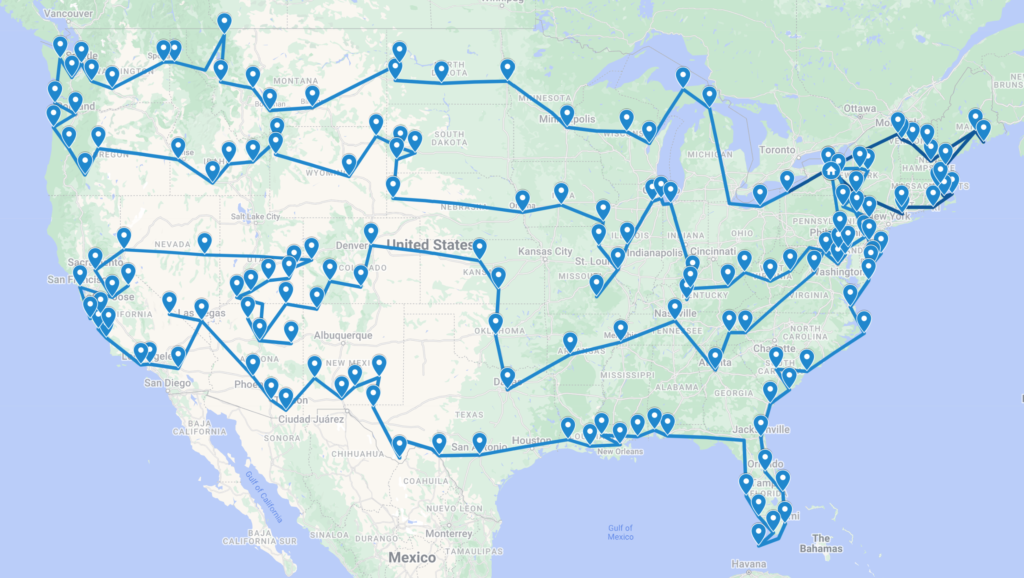It’s your basic one bed, no bath. Small kitchen. But you can’t beat the location.
Exterior
We kept the exterior alterations minor for this trip. We have no back cargo hitch carrier and no roof rack. We thought about somehow adding solar to the roof but decided against it for now. We did get custom-fit WeatherTech window coverings to put in our back windows at night to prevent anyone from seeing in. Since these coverings completely block the windows, we can fold down the top with velcro strips, allowing us to keep them slightly open for airflow. In addition, we attached custom rain guards to the car to prevent rain from coming in if we have the windows cracked. To keep bugs out, we put window socks, or fabric screens, over the rear doors. They allow us to fully open the windows without bugs getting in. The window socks also provide some privacy for the otherwise conspicuous bed platform.
Bed
The bed measures exactly four feet wide by five and a half feet long. It’s a tight fit for Spencer at 5’10” but he makes it work laying diagonally with his feet hanging off the end. There is actually more room length-wise inside the car but the bed was cut short to keep it rectangular. The four-inch memory foam mattress topper sits on our pair of yoga mats. This provides a very comfortable bed for sleeping. A set of double sheets and multiple blankets rounds out the bed design. The sleeping area is kept dark with window covers and a privacy curtain hanging behind the front seats. We used a thin aluminum bar to hold the curtain flush with the roof. We bent the ends of the bar to slide into the side panels of the car. The curtain was made from blackout curtains cut to size
Kitchen
For the kitchen, we have several features spread throughout the car. There is a small car fridge behind the passenger seat and a microwave accessible from the driver’s side rear door. Below the bed, in the back of the car, we have two short plastic containers side by side to hold all of our smaller kitchen items. This includes a pot and pan, a cast-iron skillet, utensils, plates and bowls, a compressible washbasin/cutting board, a collapsible tea kettle, and a small propane camp stove. On top of the plastic containers is a foldable table. Likewise, food is also spread around. We have bins for fresh groceries on top of the fridge. And in the middle area underneath the platform, which is accessible from the rear side doors, we store baskets of long-term cooking supplies and spices. There is also room for two gallon-sized jugs to hold clean and dirty water. We have a small garbage bin centrally located right behind the front seats.
Storage
Our design allows for plenty of storage. In the trunk area, we removed the spare tire (we have AAA) so we could store all of our camping gear. We were able to fit our tent, folding chairs, and two sleeping bags all underneath the trunk floor. The Prius comes with hard styrofoam storage receptacles in this area as well. We fit miscellaneous stuff here like tools, first aid, emergency roadside equipment, plastic bags, and spare electronics. We call this area the basement. Accessing this is easy since all the kitchen gear is stored in two bins that can be quickly removed. Between these plastic bins are two shoeboxes, one filled with laundry and cleaning supplies and the other filled with miscellaneous small items like cards and hiking gear.
Clothing
We both have two duffle bags for personal items and clothing. One for daily use and another that’s mostly for storage. Each day a fresh set of clothes moves from the storage bag to the daily bag. It’s a process but it works. Shelby stores her bags in the space under the bed on the passenger side. Spencer has room for his bags behind the driver’s seat. There is a little room for emergency cold-weather clothes in the basement.
Electronics
Perhaps the single most important piece of the setup is the extra battery. We purchased a Goal Zero 1000Core for the hefty price of $900. With 1000Wh of power delivery, several output options, a pure sine wave inverter, and car recharging capabilities, the battery plays an integral role in the trip. In addition to powering the fridge at all times, it charges our electronics as needed and can even run the 700W microwave. With switches to enable/disable certain outputs, the battery can even be used to quickly turn on or off our frame lights at night. The battery recharges whenever the car is running, and it takes about one hour of driving to recharge the battery from a night of powering the fridge and charging our phones. We both have Microsoft Surface laptops and Samsung smartphones.
Note: This page contains Amazon affiliate links. Please consider supporting our blog by purchasing through these links. We will receive a small commission at no extra cost to you.




























